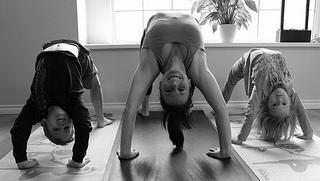
Reflections on Play
Engaging Children, Building Skills
March 5, 2014
NIEER is hosting a blog forum on play-based learning in early childhood education, including posts from national experts in the field. Learn more about the forum here. Some worry that the push for quality education even partially driven by a desire to improve achievement may deprive children of important childhood experiences. Others worry that unstructured play without teacher engagement does little to develop children’s minds, particularly for children at high risk of academic failure.
By Melissa Dahlin, CEELO Research Associate
Learning through play is an effective (and fun!) tool to help children reach positive outcomes. I believe this not only because of the evidence from research, but also from having used it in my own preschool classroom. However, it was my own recent experience at a training session on using yoga with young children that convinced me beyond a doubt that play is effective.
The training could have included a lecture, some demonstrations, and some handouts. I would have listened, taken notes, and then gone home and told myself I’d review the material another day. And then a month later I’d come across it again while cleaning and remind myself to review it later. And repeat.

Fortunately, this was a different type of training. The trainer’s focus was on children learning yoga through play-based activities, and we were to do the activities ourselves as if we were the kids and (here was the kicker) – no note-taking. This produced a minor panic moment – how in the world would I remember any of it and be able use it afterwards? I decided to make the training a test of my own belief that learning through play works.
The trainer was intentional – she had specific goals; linked them to our interests and backgrounds; and provided the opportunities and asked the questions to guide us in our learning. The activities were supplemented with both individual discussion with her and group discussion and reflection. My first impression was that it was really fun, but I fretted I wouldn’t have more than an impression of the activities after leaving.
The day after the training, I decided it was time to see what I remembered. Within moments, I had two pages of a notebook filled up with very rich, actionable information. How was that possible? I realized that I was able to remember in vivid detail because I had been so engaged while doing it. Rather than thinking about an activity in the abstract, I recalled the thoughts, feelings, and reflections I had experienced during the activities and discussions. By using intentional play as a medium, the activities had become meaningful and tangible.
A common theme running through the training was mindfulness: using play to teach children awareness about their bodies, including their brain – skills that included self-regulation, focus, and persistence. Though I was learning the material to use with children, I found that I, too, learned skills that were transferable and helpful in my professional and personal life. The experience further reinforced my belief that play is not only an engaging way for children to learn content in the now, but also a way to build the skills to prepare students to master future learning, both academically and in life.
Tell us in the comments below about your own experiences teaching—or learning—through play.
About NIEER
The National Institute for Early Education Research (NIEER) at the Graduate School of Education, Rutgers University, New Brunswick, NJ, conducts and disseminates independent research and analysis to inform early childhood education policy.
